In Situ Uniaxial Compression of Textured Magnesium AZ31B †
Abstract
:1. Introduction
2. Materials and Method
3. Results and Discussion
4. Summary and Conclusions
Author Contributions
Funding
Institutional Review Board Statement
Informed Consent Statement
Data Availability Statement
Acknowledgments
Conflicts of Interest
References
- Polmear, I.J. Magnesium alloys and applications. J. Mater. Sci. Technol. 1994, 10, 1–16. [Google Scholar] [CrossRef]
- Tan, J.; Ramakrishna, S. Applications of Magnesium and Its Alloys: A Review. Appl. Sci. 2021, 11, 6861. [Google Scholar] [CrossRef]
- Prasad, S.V.S.; Prasad, S.B.; Verma, K.; Mishra, R.K.; Kumar, V.; Singh, S. The role and significance of Magnesium in modern day research-A review. J. Magnes. Alloys 2021, 10, 1–61. [Google Scholar] [CrossRef]
- Luo, A.A. Magnesium: The Lightest Structural Metal; International Magnesium Association: Saint Paul, MN, USA, 2018; pp. 1–47. [Google Scholar]
- Serra, A.; Bacon, D.J.; Osetsky, Y.N. Strengthening and microstructure modification associated with moving twin boundaries in hcp metals. Philos. Mag. Lett. 2007, 87, 451–459. [Google Scholar] [CrossRef]
- Barnett, M.R. Twinning and the ductility of magnesium alloys. Mater. Sci. Eng. A 2007, 464, 1–7. [Google Scholar] [CrossRef]
- Hosford, W.F. Miller–Bravais Indices for Hexagonal Crystals. In Materials Science; Cambridge University Press: Cambridge, UK, 2006; Chapter 3; pp. 21–25. [Google Scholar] [CrossRef]
- Agnew, S.R. Deformation mechanisms of magnesium alloys. In Advances in Wrought Magnesium Alloys; Woodhead Publishing Series in Metals and Surface Engineering; Woodhead Publishing: Sawston, UK, 2012; pp. 63–104. [Google Scholar] [CrossRef]
- Jayasathyakawin, S.; Ravichandran, M.; Baskar, N.; Anand Chairman, C.; Balasundaram, R. Mechanical properties and applications of Magnesium alloy. Mater. Today Proc. 2020, 27, 909–913. [Google Scholar] [CrossRef]
- Christian, J.W.; Mahajan, S. Deformation twinning. Prog. Mater. Sci. 1995, 39, 1–157. [Google Scholar] [CrossRef]
- Nie, J.F.; Shin, K.S.; Zeng, Z.R. Microstructure, deformation, and property of wrought magnesium alloys. Metall. Mater. Trans. A 2020, 51, 6045–6109. [Google Scholar] [CrossRef]
- Graff, S.; Brocks, W.; Steglich, D. Yielding of magnesium: From single crystal to polycrystalline aggregates. Int. J. Plast. 2007, 23, 1957–1978. [Google Scholar] [CrossRef]
- Agnew, S.R.; Duygulu, Ö. Plastic anisotropy and the role of non-basal slip in magnesium alloy AZ31B. Int. J. Plast. 2005, 21, 1161–1193. [Google Scholar] [CrossRef]
- Beyerlein, I.J.; Arul Kumar, M. The Stochastic Nature of Deformation Twinning: Application to HCP Materials. In Handbook of Materials Modeling; Andreoni, W., Yip, S., Eds.; Springer: Cham, Switzerland, 2018. [Google Scholar] [CrossRef]
- Partridge, P.G. The crystallography and deformation modes of hexagonal close-packed metals. Metall. Rev. 1967, 12, 169–194. [Google Scholar] [CrossRef]
- Yu, H.; Li, C.; Xin, Y.; Chapuis, A.; Huang, X.; Liu, Q. The mechanism for the high dependence of the Hall-Petch slope for twinning/slip on texture in Mg alloys. Acta Mater. 2017, 128, 313–326. [Google Scholar] [CrossRef]
- Luo, A.A.; Shi, R.; Miao, J.; Avey, T. Review: Magnesium Sheet Alloy Development for Room Temperature Forming. JOM 2021, 73, 1403–1418. [Google Scholar] [CrossRef]
- Lou, X.; Li, M.; Boger, R.; Agnew, S.; Wagoner, R. Hardening evolution of AZ31B Mg sheet. Int. J. Plast. 2007, 23, 44–86. [Google Scholar] [CrossRef]
- Seipp, S.; Wagner, M.F.-X.; Hockauf, K.; Schneider, I.; Meyer, L.W.; Hockauf, M. Microstructure, crystallographic texture and mechanical properties of the magnesium alloy AZ31B after different routes of thermo-mechanical processing. Int. J. Plast. 2012, 35, 155–166. [Google Scholar] [CrossRef]
- Zum Gahr, K.-H. (Ed.) Chapter 2 Microstructure and Mechanical Properties of Materials. Tribol. Ser. 1987, 10, 8–47. [Google Scholar] [CrossRef]
- Shackelford, J.F. Introduction to Materials Science for Engineers, 8th ed.; Pearson: London, UK, 2014. [Google Scholar]
- Hosford, W.F. Mechanical Behavior of Materials; Cambridge University Press: New York, NY, USA, 2005. [Google Scholar]
- Rakshith, M.; Seenuvasaperumal, P. Review on the effect of different processing techniques on the microstructure and mechanical behaviour of AZ31 Magnesium alloy. JMA 2021, 9, 1692–1714. [Google Scholar] [CrossRef]
- Hazeli, K.; Cuadra, J.; Vanniamparambil, P.A.; Kontsos, A. In situ identification of twin-related bands near yielding in a magnesium alloy. Scr. Mater. 2013, 68, 83–86. [Google Scholar] [CrossRef]
- Lagattu, F.; Brillaud, J.; Lafarie-Frenot, M.C. High strain gradient measurements by using digital image correlation technique. Mater. Charact. 2004, 53, 17–28. [Google Scholar] [CrossRef]
- Denk, J.; Nischler, A.; Whitmore, L.; Huber, O.; Saage, H. Discontinuous and inhomogeneous strain distributions under monotonic and cyclic loading in textured wrought magnesium alloys. Mat. Sci. Eng. A 2019, 764, 138182. [Google Scholar] [CrossRef]
- Denk, J. Model for the Fatigue Behavior of Wrought Magnesium Structures Based on Mechanical and Microstructural Characterization; LC Verlag: Landshut, Germany, 2019; ISBN 978-3-9818439-3-4. URN: urn:nbn:de:bvb:860-opus4-185. [Google Scholar]
- Whitmore, L.; Denk, J.; Zickler, G.A.; Bourret, G.R.; Huber, O.; Huesing, N.; Diwald, O. Macro to nano: A microscopy study of a wrought magnesium alloy after deformation. Eur. J. Phys. 2019, 40, 045501. [Google Scholar] [CrossRef]
- Dingley, D.J.; Meaden, G.; Dingley, D.J.; Day, A.P. A review of EBSD: From rudimentary on line orientation measurements to high resolution elastic strain measurements over the past 30 years. IOP Conf. Ser. Mater. Sci. Eng. 2018, 375, 012003. [Google Scholar] [CrossRef]
- Schwartz, A.J.; Kumar, M.; Adams, B.L.; Field, D.P. (Eds.) Electron Backscatter Diffraction in Materials Science, 2nd ed.; Springer: New York, NY, USA, 2009. [Google Scholar]
- Wert, J.A.; Huang, X.; Winther, G.; Pantleon, W.; Poulsen, H.F. Revealing deformation microstructures. Mater. Today 2007, 10, 24–32. [Google Scholar] [CrossRef]
- Zaefferer, S. A critical review of orientation microscopy in SEM and TEM. Cryst. Res. Technol. 2011, 46, 607–628. [Google Scholar] [CrossRef]
- Humphreys, F.J. Grain and sub-grain characterisation by electron backscatter diffraction. J. Mater. Sci. 2001, 36, 3833–3854. [Google Scholar] [CrossRef]
- Carneiro, I.; Simões, S. Recent advances in EBSD characterization of metals. Metals 2020, 10, 1097. [Google Scholar] [CrossRef]
- Humphreys, F.J. Characterisation of fine-scale microstructures by electron backscatter diffraction (EBSD). Scr. Mater. 2004, 51, 771–776. [Google Scholar] [CrossRef]
- Kainuma, Y. The theory of Kikuchi patterns. Acta Crystallogr. 1955, 8, 247–257. [Google Scholar] [CrossRef]
- Michael, J.R.; Goehner, R.P. Advances in backscattered electron Kikuchi patterns for crystallographic phase identification. In Proceedings of the 52nd Annual Meeting of MSA, New Orleans, LA, USA, 31 July–5 August 1994; pp. 596–597. [Google Scholar]
- Sneddon, G.C.; Trimby, P.W.; Cairney, J.M. Transmission Kikuchi diffraction in a scanning electron microscope: A review. Mater. Sci. Eng. 2016, 110, 1–12. [Google Scholar] [CrossRef]
- Shi, Q.; Jiao, L.; Loisnard, D.; Dan, C.; Chen, Z.; Wang, H.; Roux, S. Improved EBSD indexation accuracy by considering energy distribution of diffraction patterns. Mater. Charact. 2022, 188, 111909. [Google Scholar] [CrossRef]
- Chen, D.; Kuo, J.-C.; Wu, W.-T. Effect of microscopic parameters on EBSD spatial resolution. Ultramicroscopy 2011, 111, 1488–1494. [Google Scholar] [CrossRef] [PubMed]
- Kopec, M. Compression and fatigue testing of high-strength thin metal sheets by using an anti-buckling device. Exp. Mech. 2023, 63, 1003–1013. [Google Scholar] [CrossRef]
- Stoudt, M.R.; Levine, L.E.; Ma, L. Designing a uniaxial tension/compression test for springback analysis in high-strength steel sheets. Exp. Mech. 2017, 57, 155–163. [Google Scholar] [CrossRef] [PubMed]
- Nowell, M.M.; Witt, R.A.; True, B. EBSD sample preparation: Techniques, tips, and tricks. Microsc. Today 2005, 13, 44–49. [Google Scholar] [CrossRef]
- Voort, G.V.; van Geertruyden, W.; Dillon, S.; Manilova, E. Metallographic preparation for electron backscattered diffraction. Microsc. Microanal. 2006, 12, 1610–1611. [Google Scholar] [CrossRef]
- Taheri, M.; Phillips, R.C.; Kish, J.R.; Botton, G.A. Analysis of the surface film formed on Mg by exposure to water using a FIB cross-section and STEM–EDS. Corros. Sci. 2012, 59, 222–228. [Google Scholar] [CrossRef]
- Whitmore, L.; Nischler, A.; Huber, O. Preparation of magnesium AZ31B for electron backscatter diffraction (EBSD) analysis. In [Hrsg.]: 11. Landshuter Leichtbau-Colloquium; Huber, O., Bicker, M., Patzelt, P., Eds.; LC-Verlag: Landshut, Germany, 2023; ISBN 978-3-9818439-7-2. [Google Scholar]
- Dingley, D.J. A simple straining stage for the scanning electron microscope. Micron 1969, 1, 206–210. [Google Scholar] [CrossRef]
- Li, K.; Bu, Y.; Wang, H. Advances on in situ TEM mechanical testing techniques: A retrospective and perspective view. Front. Mater. 2023, 10, 1207024. [Google Scholar] [CrossRef]
- Wilsdorf, H.G.F. Apparatus for the deformation of foils in an electron microscope. Rev. Sci. Instrum. 1958, 29, 323–324. [Google Scholar] [CrossRef]
- Kahla, S.; LinPeng, R.; Calmunger, M.; Olsson, B.; Johansson, S. In situ EBSD during tensile test of aluminum AA3003 sheet. Micron 2014, 58, 15–24. [Google Scholar] [CrossRef]
- Dittrich, J.; Farkas, G.; Drozdenko, D.; Knapek, M.; Máthis, K.; Minárik, P. Advanced in-situ experimental techniques for characterization of deformation mechanisms in magnesium alloys. J. Alloys Compd. 2023, 937, 168388. [Google Scholar] [CrossRef]
- Gong, W.; Zheng, R.; Harjo, S.; Kawasaki, T.; Aizawa, K.; Tsuji, N. In-situ observation of twinning and detwinning in AZ31 alloy. J. Magnes. Alloys 2022, 10, 3418–3432. [Google Scholar] [CrossRef]
- Denk, J.; Whitmore, L.; Huber, O.; Diwald, O.; Saage, H. Concept of the highly strained volume for fatigue modeling of wrought magnesium alloys. Int. J. Fatigue 2018, 117, 283–291. [Google Scholar] [CrossRef]
- Kawalla, R.; Oswald, M.; Schmidt, C. New technology for the production of magnesium strips and sheets. J. Metall. 2008, 47, 195–198. [Google Scholar]
- Nischler, A.; Huber, O. Entwicklung eines Materialmodells zur Simulation des inhomogenen 3D-Dehnungsfelds von texturierten Magnesium-Knetlegierungen mittels der FEM. In 11. Landshuter Leichtbau-Colloquium; Huber, O., Bicker, M., Patzelt, P., Eds.; LC-Verlag: Landshut, Germany, 2023; ISBN 978-3-9818439-7-2. [Google Scholar]
- Mattheck, C.; Kappel, R.; Sauer, A. Shape optimization the easy way: The ‘method of tensile triangles’. Int. J. Des. Nat. 2007, 2, 301–309. [Google Scholar] [CrossRef]
- Tripathi, A.; Zaefferer, S. On the resolution of EBSD across atomic density and accelerating voltage with a particular focus on the light metal magnesium. Ultramicroscopy 2019, 207, 112828. [Google Scholar] [CrossRef] [PubMed]
- Beausir, B.; Fundenberger, J.J. Analysis Tools for Electron and X-ray Diffraction; ATEX-software; Université de Lorraine: Metz, France, 2017; Available online: www.atex-software.eu (accessed on 14 December 2023).
- Randolph, S.J.; Fowlkes, J.D.; Rack, P.D. Focused, nanoscale electron-beam-induced deposition and etching. Crit. Rev. Solid State Mater. Sci. 2006, 31, 55–89. [Google Scholar] [CrossRef]
- Gruber, J.A.; Brown, S.A.; Lucadamo, G.A. Generalized Kearns texture factors and orientation texture measurement. J. Nucl. Mater. 2011, 408, 176–182. [Google Scholar] [CrossRef]
- Liu, Y.; Tang, P.Z.; Gong, M.Y.; McCabe, R.J.; Wang, J.; Tomé, C.N. Three-dimensional character of the deformation twin in magnesium. Nat. Commun. 2019, 10, 3308. [Google Scholar] [CrossRef]
- Wu, L.; Agnew, S.R.; Brown, D.W.; Stoica, G.M.; Clausen, B.; Jain, A.; Fielden, D.E.; Liaw, P.K. Internal stress relaxation and load redistribution during the twinning–detwinning-dominated cyclic deformation of a wrought magnesium alloy, ZK60A. Acta Mater. 2008, 56, 3699–3707. [Google Scholar] [CrossRef]
- Liu, T.; Yang, Q.; Guo, N.; Lu, Y.; Song, B. Stability of twins in Mg alloys—A short review. J. Magnes. Alloys 2020, 8, 66–77. [Google Scholar] [CrossRef]
- Whitmore, L.C.; Denk, J.; Zickler, G.A.; Bourret, G.R.; Huber, O.; Saage, H.; Huesing, N.; Diwald, O. Microstructural investigation of twin-roll cast magnesium AZ31B subjected to a single monotonic compressive stress. J. Alloys Compd. 2019, 789, 1022–1034. [Google Scholar] [CrossRef]
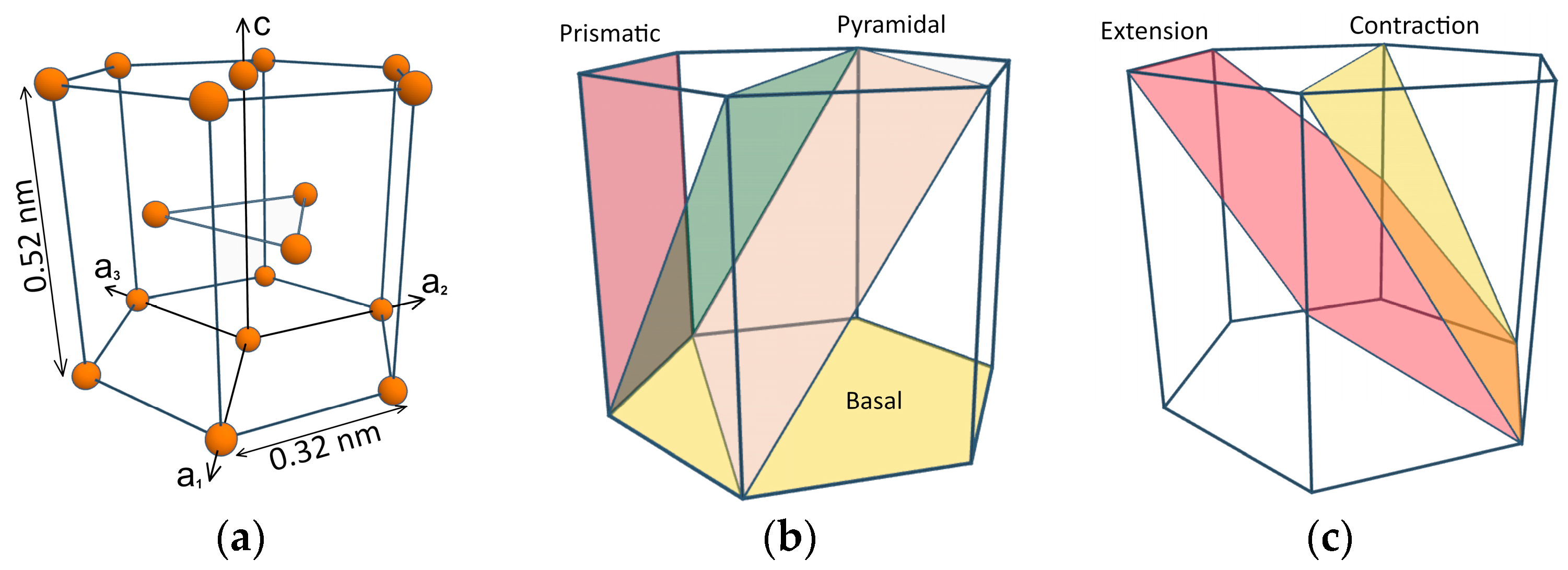
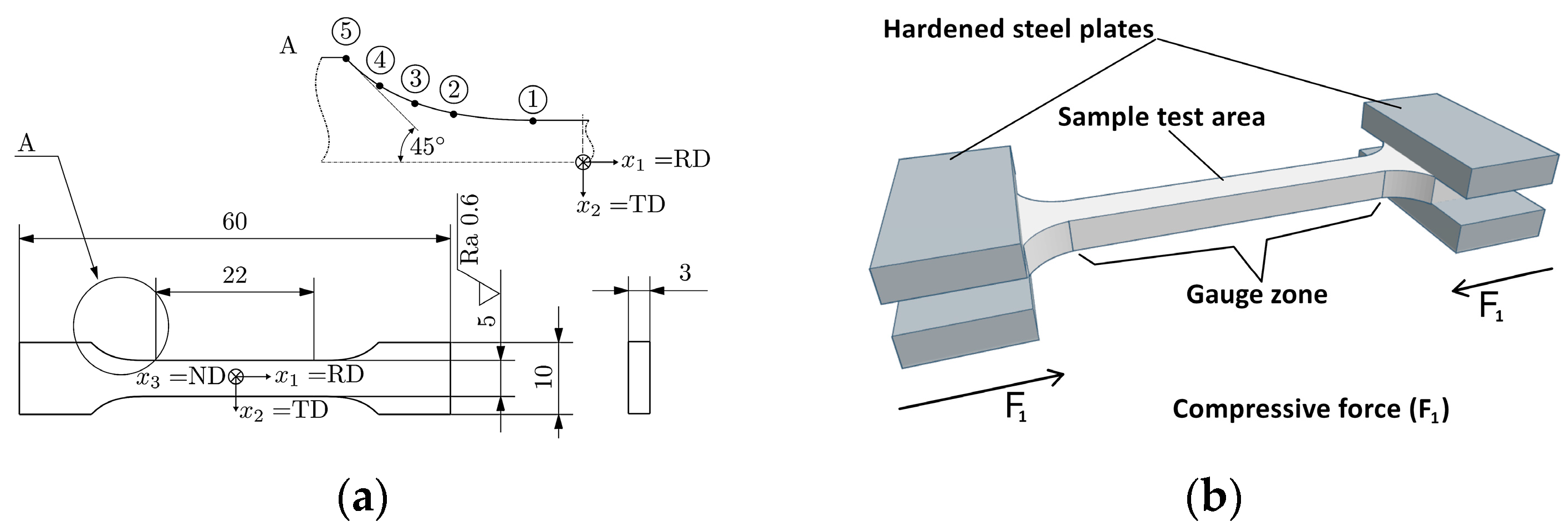
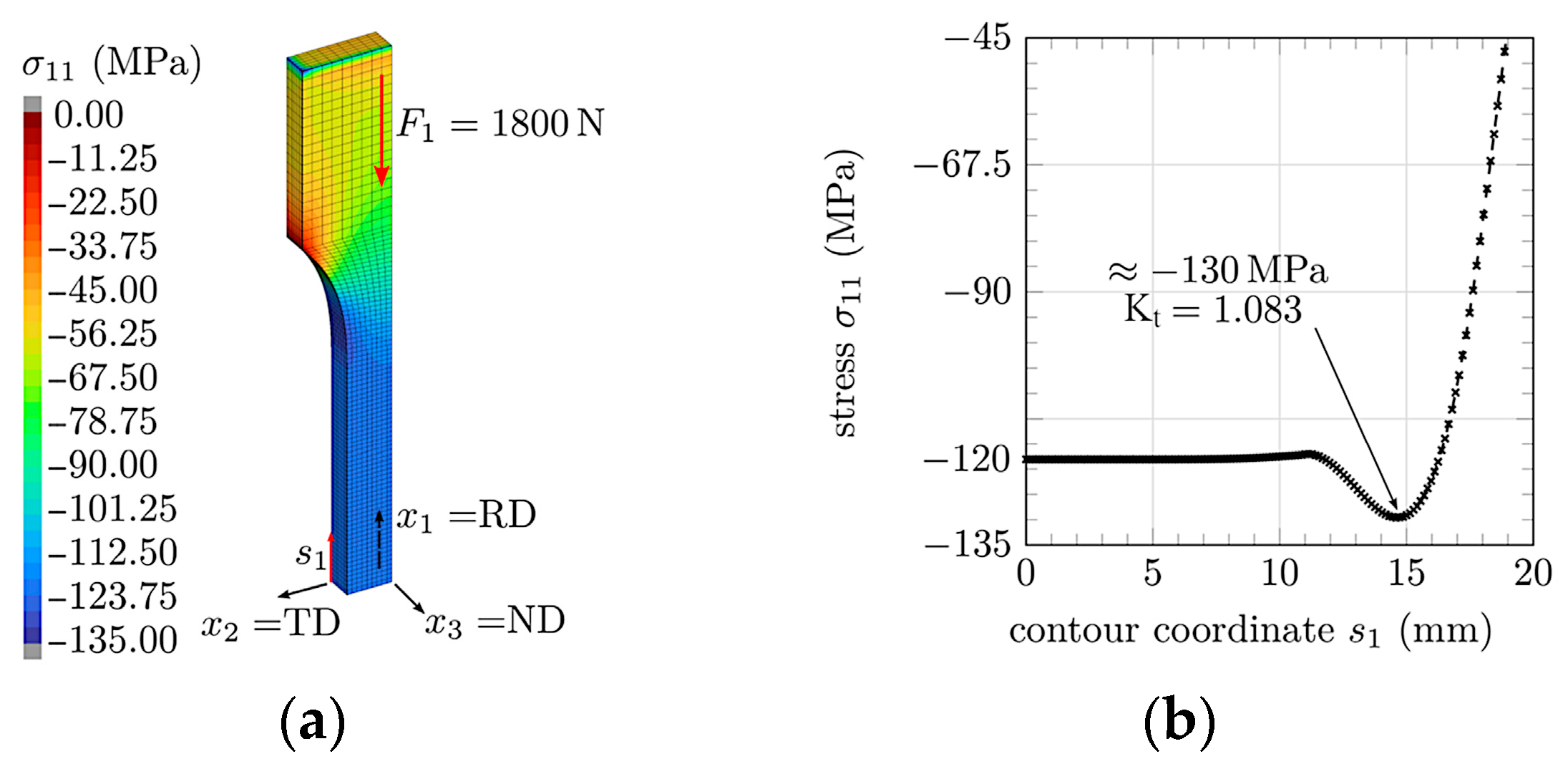
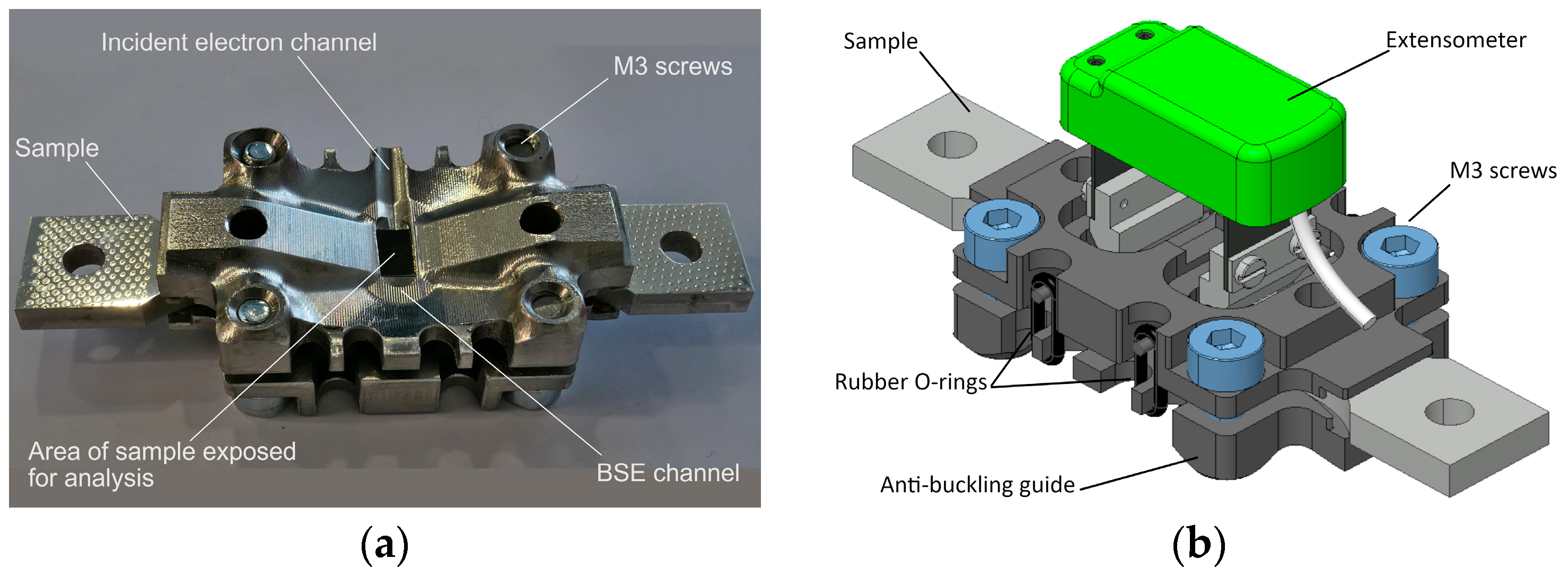
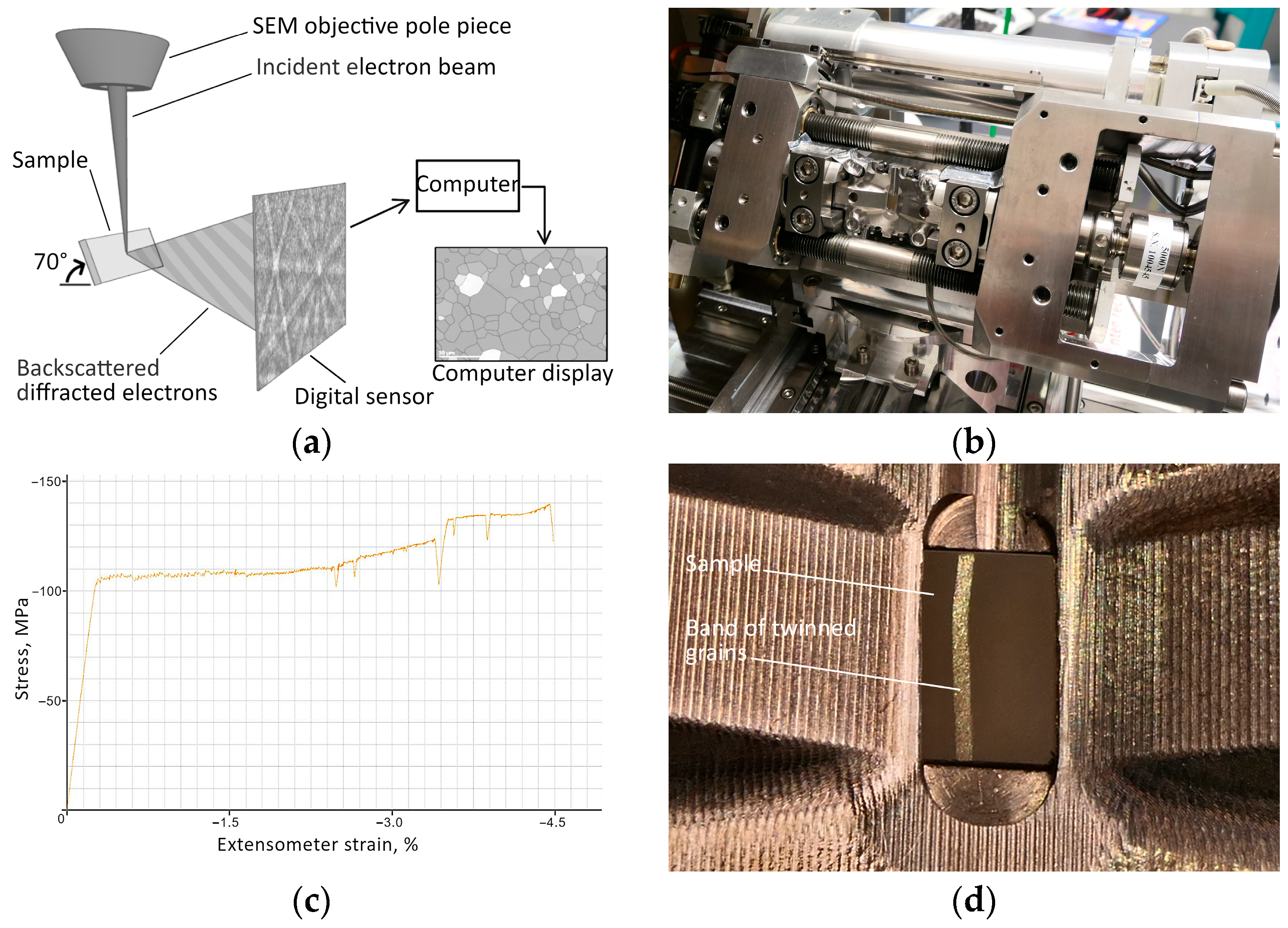
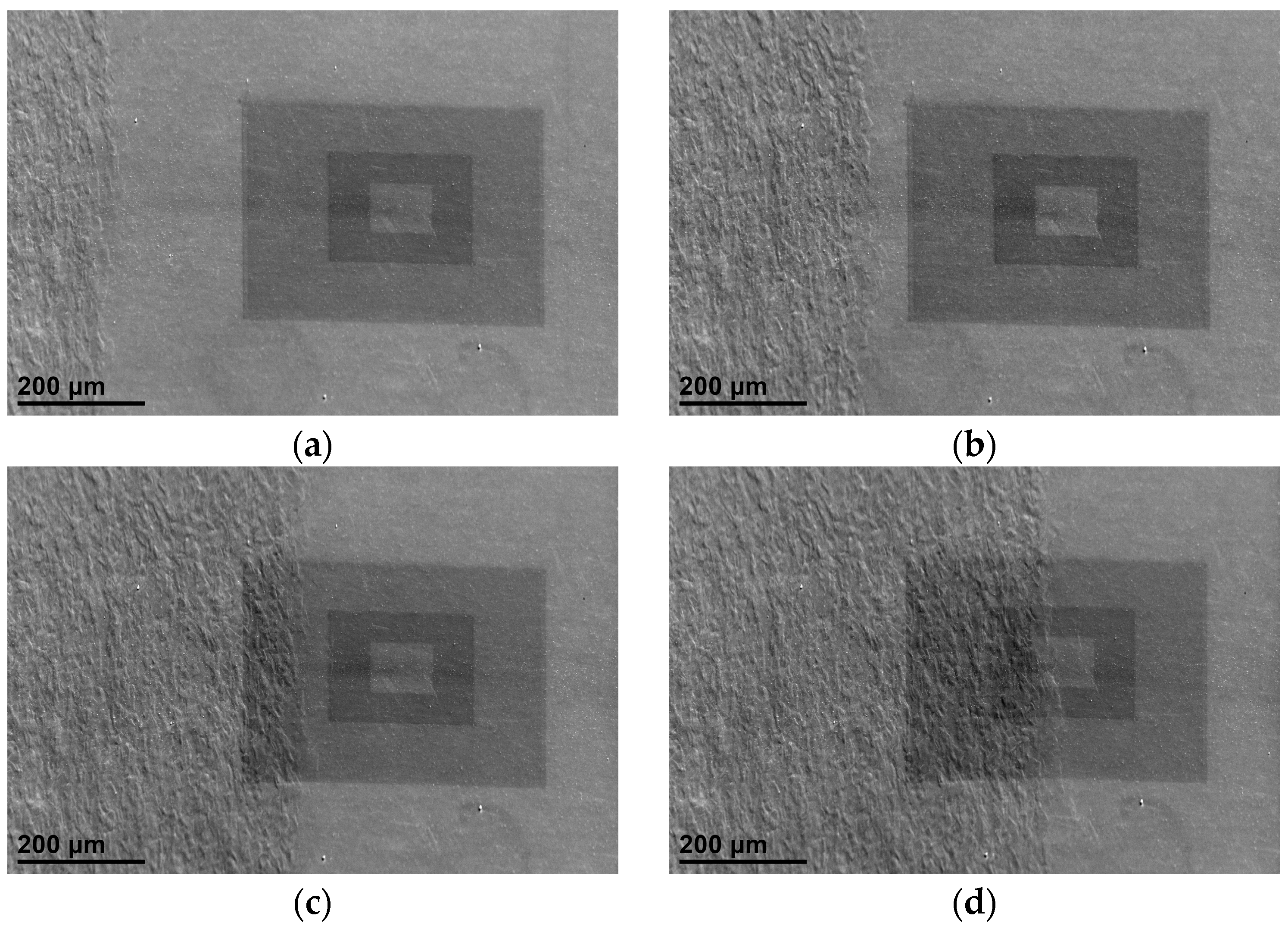
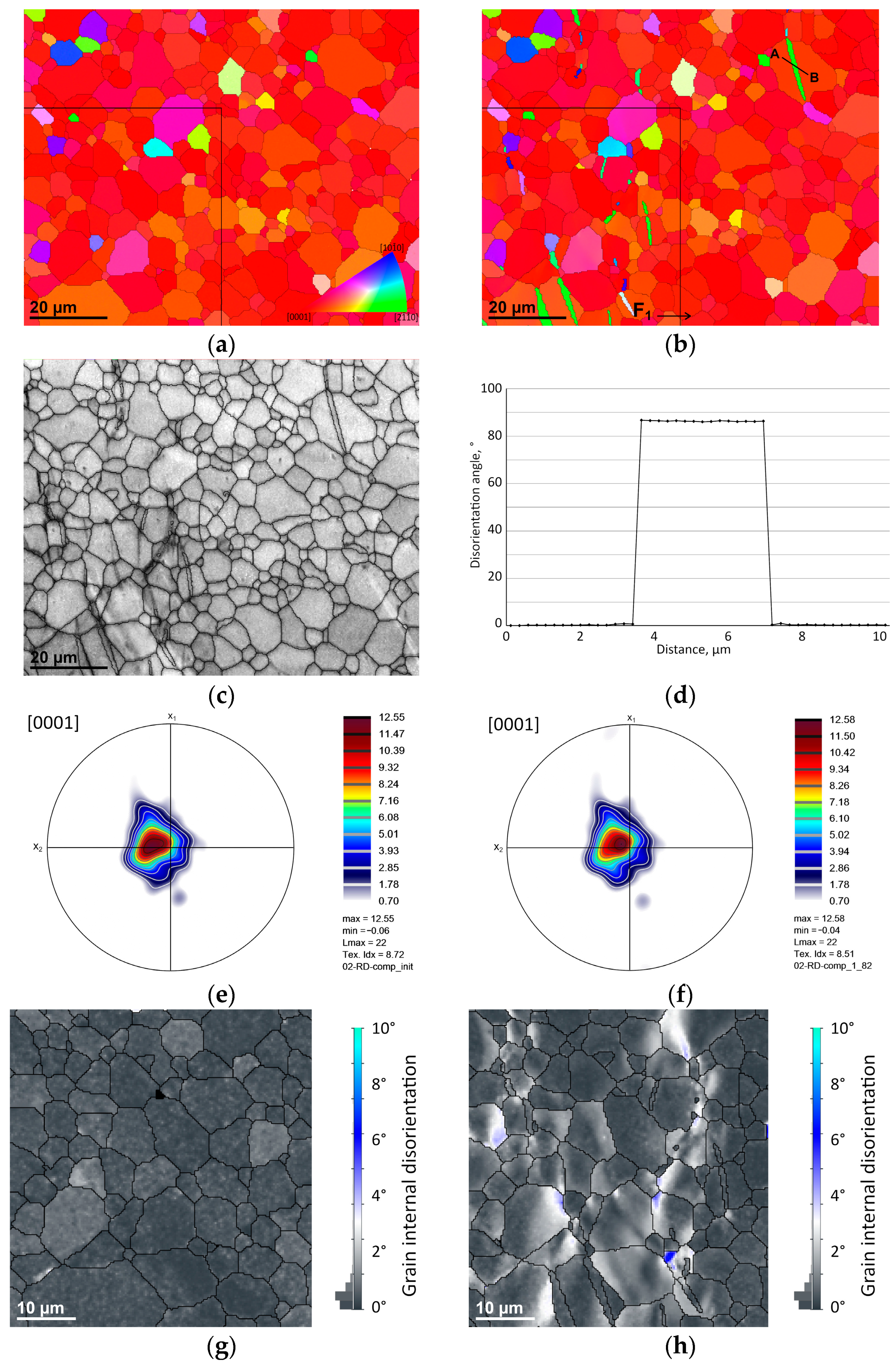
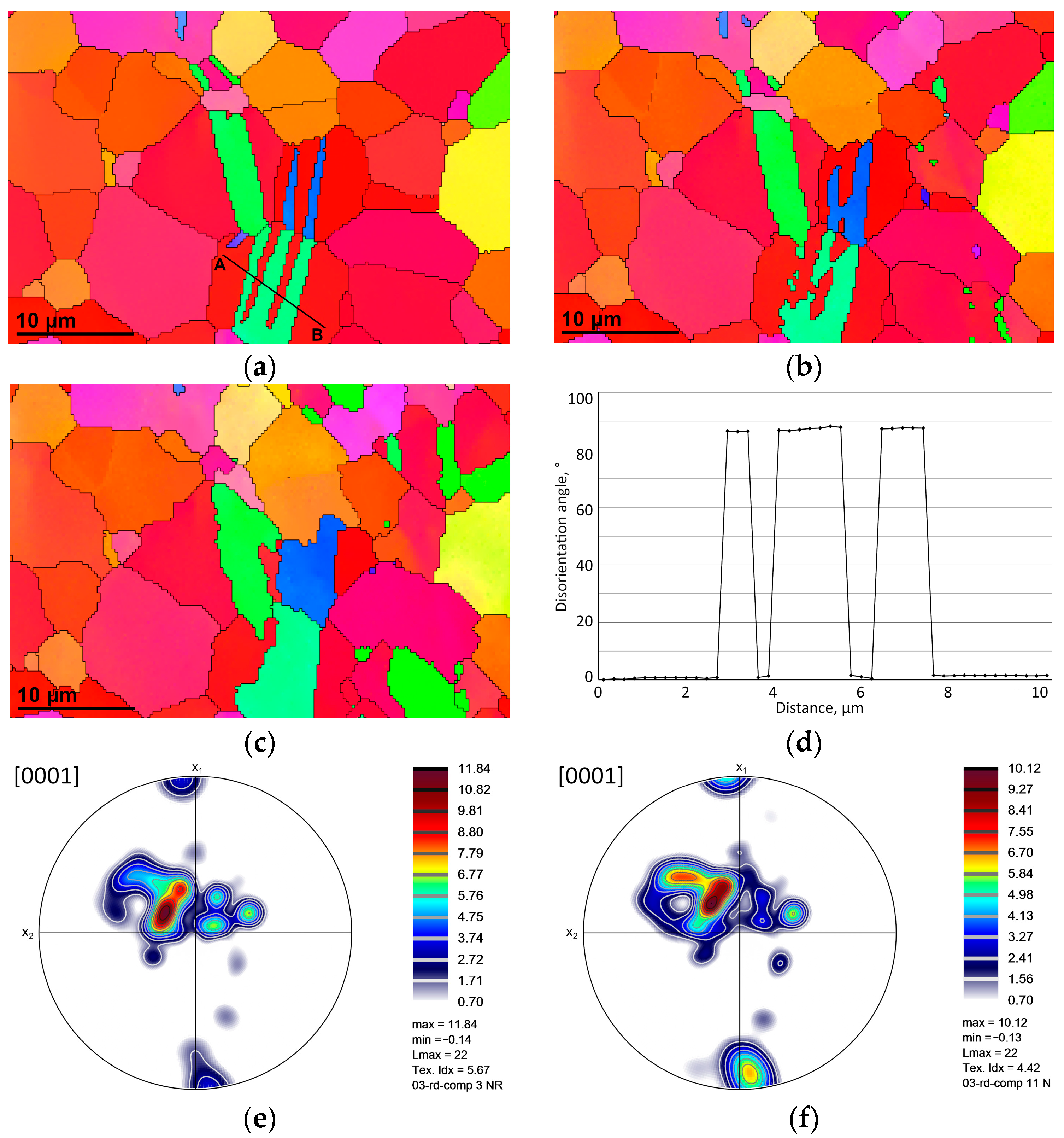

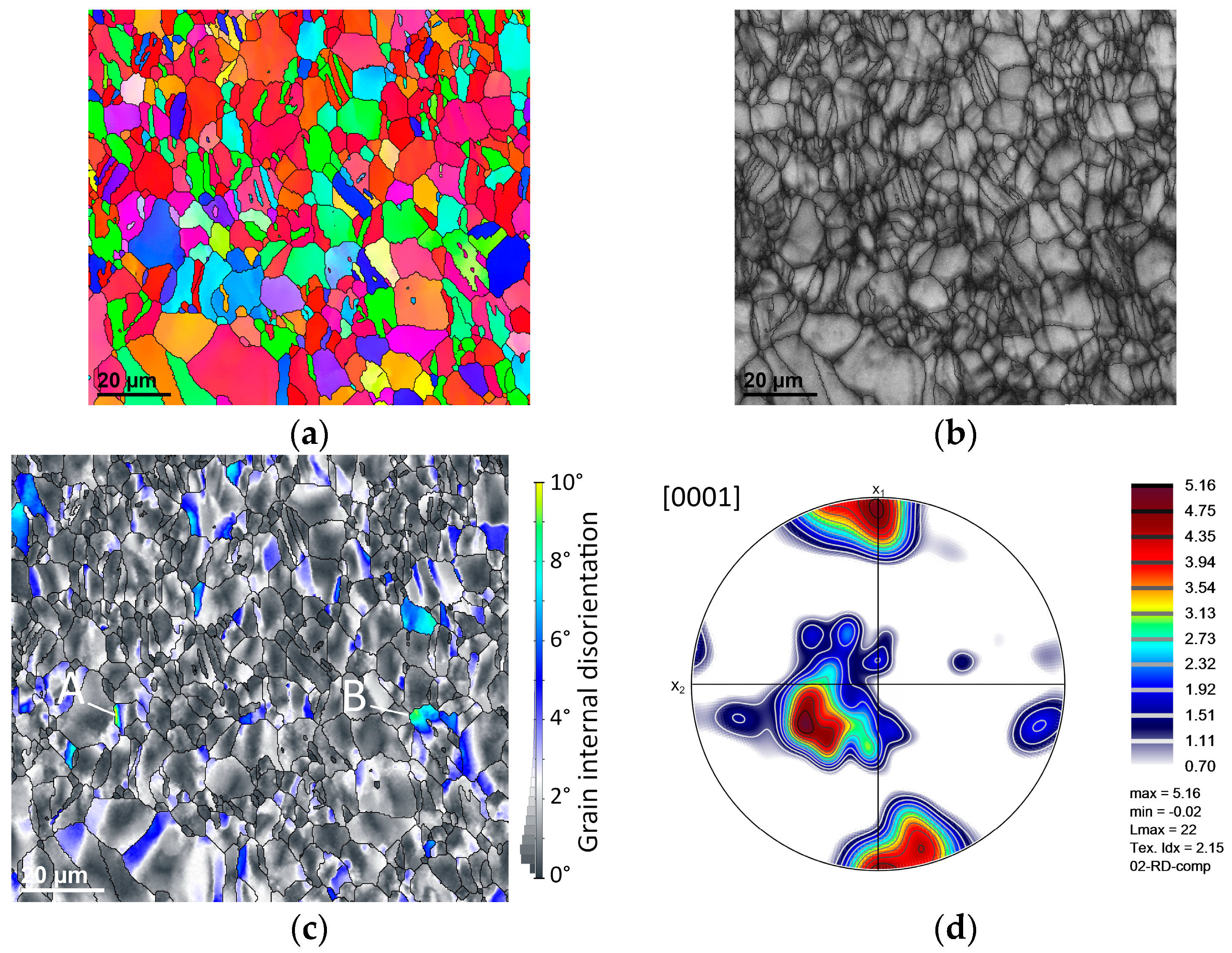
| Coordinates | Point 1 | Point 2 | Point 3 | Point 4 | Point 5 |
|---|---|---|---|---|---|
| (mm) | −11.0 | −15.0 | −16.8 | −19.0 | −20.0 |
| (mm) | −2.50 | −2.62 | −3.00 | −4.13 | −5.00 |
Disclaimer/Publisher’s Note: The statements, opinions and data contained in all publications are solely those of the individual author(s) and contributor(s) and not of MDPI and/or the editor(s). MDPI and/or the editor(s) disclaim responsibility for any injury to people or property resulting from any ideas, methods, instructions or products referred to in the content. |
© 2023 by the authors. Licensee MDPI, Basel, Switzerland. This article is an open access article distributed under the terms and conditions of the Creative Commons Attribution (CC BY) license (https://creativecommons.org/licenses/by/4.0/).
Share and Cite
Whitmore, L.; Nischler, A.; Saage, H.; Huber, O. In Situ Uniaxial Compression of Textured Magnesium AZ31B. Metals 2024, 14, 20. https://doi.org/10.3390/met14010020
Whitmore L, Nischler A, Saage H, Huber O. In Situ Uniaxial Compression of Textured Magnesium AZ31B. Metals. 2024; 14(1):20. https://doi.org/10.3390/met14010020
Chicago/Turabian StyleWhitmore, Lawrence, Anton Nischler, Holger Saage, and Otto Huber. 2024. "In Situ Uniaxial Compression of Textured Magnesium AZ31B" Metals 14, no. 1: 20. https://doi.org/10.3390/met14010020
APA StyleWhitmore, L., Nischler, A., Saage, H., & Huber, O. (2024). In Situ Uniaxial Compression of Textured Magnesium AZ31B. Metals, 14(1), 20. https://doi.org/10.3390/met14010020






